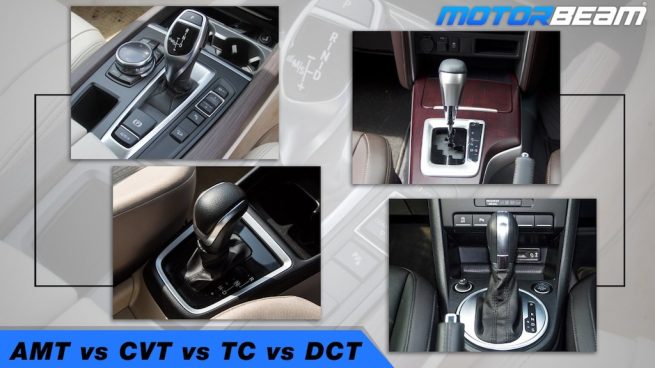There are different types of automatic gearboxes available and we explain them to you.
AMT vs CVT vs TC vs DCT
Demand for automatic cars is increasing and you get different types of automatic gearboxes in different cars. There’s AMT, CVT, torque convertor, and DCT/DSG. Let me explain to you how each one of them works.
AMT – We’ll start off with AMT which is relatively new and comes with basic mechanicals. AMT is an Automated Manual Transmission, so it is not a proper automatic gearbox but a manual gearbox which facilitates gear shifting without the need to move the gear knob or use the clutch pedal. It comes with a hydraulic actuator system and an electronic control unit which work together to engage and disengage the clutch while changing gears. AMTs are cost-effective and the fuel efficiency is similar to a manual transmission but the gear shifts are slow and jerky. AMTs are mostly offered on mass-market cars like the Maruti Wagon R, Hyundai Santro, Datsun redi-GO. Even the Renault Duster diesel used to come with an AMT.
CVT – CVT stands for Continuously Variable Transmission and it consists of a single unique gear that can switch through a range of continuous gear ratios. CVT uses belts or pulleys instead of steel gears. It offers a smooth drive but when you accelerate hard, you can feel the rubberband effect and it feels a bit laggy during hard acceleration. The CVT offers good fuel economy if you drive sedately and is quite smooth even in heavy traffic conditions. Cars like the Honda City, Hyundai Creta 1.5 petrol and Maruti Baleno come with a CVT. The old Audi A4 had a CVT too.
Torque Convertor – Torque Convertor is the most popular type of an automatic gearbox and it is used on mass-market cars and luxury cars. This gearbox uses a torque convertor instead of a clutch to engage and disengage an engine’s torque. There is a sealed case inside and an impeller pushes fluid to drive a turbine on the other side of the case. The gears are arranged around each other and the gearbox computer decides which gear to slot in, depending on the driving condition to suit cruising or acceleration. It offers smooth and quick gearshifts but fuel efficiency tends to fall. You can find torque convertors in cars like the Toyota Innova Crysta, Hyundai Creta diesel, Tata Harrier and even luxury cars from the stables of BMW and Jaguar.
DCT – DCT stands for Dual-Clutch Transmission while DSG means Direct Shift Gearbox. This gearbox uses two clutches instead of a single clutch. The shaft of one clutch manages the odd-numbered gears while the shaft of the second clutch manages the even-numbered gears. As one clutch disengages a gear, the second clutch immediately engages another gear and thus the time spent in neutral is eliminated. DCT/DSG gearboxes are known for their quick gear shifts and these gearboxes usually are more fuel efficient than a manual gearbox. The mechanism of a DCT is complex and costs are high too. DSG transmissions are available with dry clutches or wet clutches and the former tends to over-heat sometimes in bumper-to-bumper traffic if the driver constantly keeps the car in D. The Hyundai Creta and Kia Seltos 1.4 turbo petrol come with a DCT while lots of cars from Volkswagen, Skoda, and Audi come with a DSG.

